Detailed Report on the United States Intelligence Community Structure
VerifiedAdded on 2022/10/19
|6
|1113
|6
Report
AI Summary
This report provides a comprehensive overview of the United States Intelligence Community (IC), detailing its complex structure, which is governed by numerous laws, directives, and strategies. The IC's primary function is to provide crucial data to U.S. policymakers, officials, and military personnel, achieved through the intelligence cycle involving tasking, collection, processing, analysis, and dissemination. The report examines the role of the IC in homeland security, involving 16 agencies, including the Office of the Director of National Intelligence (ODNI) and the Central Intelligence Agency (CIA), and their collaboration with various sectors to protect national security. It also discusses the types of intelligence gathered, the advanced technologies employed, and the limitations associated with gathering and sharing information. Furthermore, the report presents a hierarchical flow chart illustrating the flow of intelligence within the IC, emphasizing the importance of data protection, effective information sharing, and the potential for improving global security. The report also includes a detailed list of references.
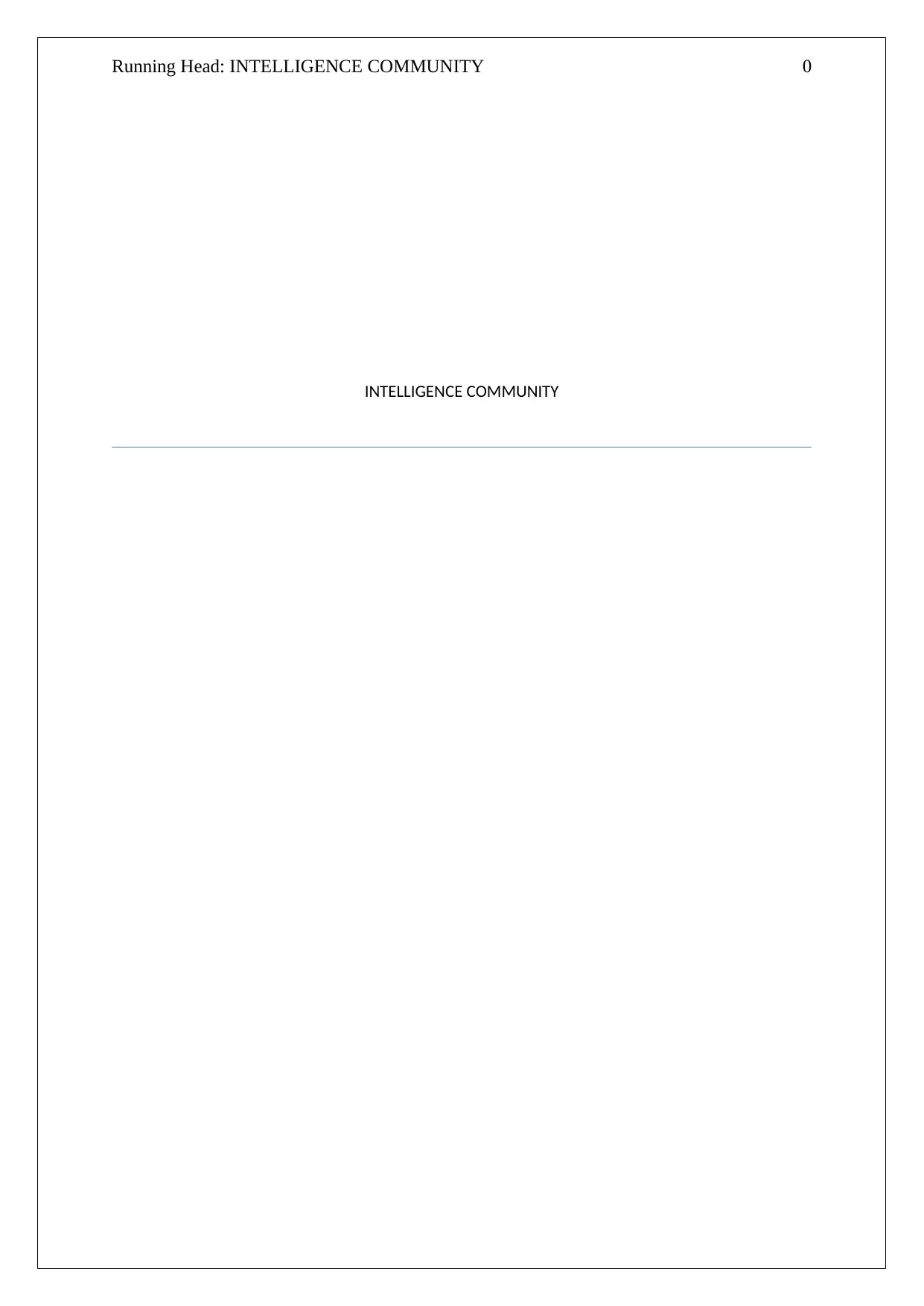
Running Head: INTELLIGENCE COMMUNITY 0
INTELLIGENCE COMMUNITY
INTELLIGENCE COMMUNITY
Paraphrase This Document
Need a fresh take? Get an instant paraphrase of this document with our AI Paraphraser
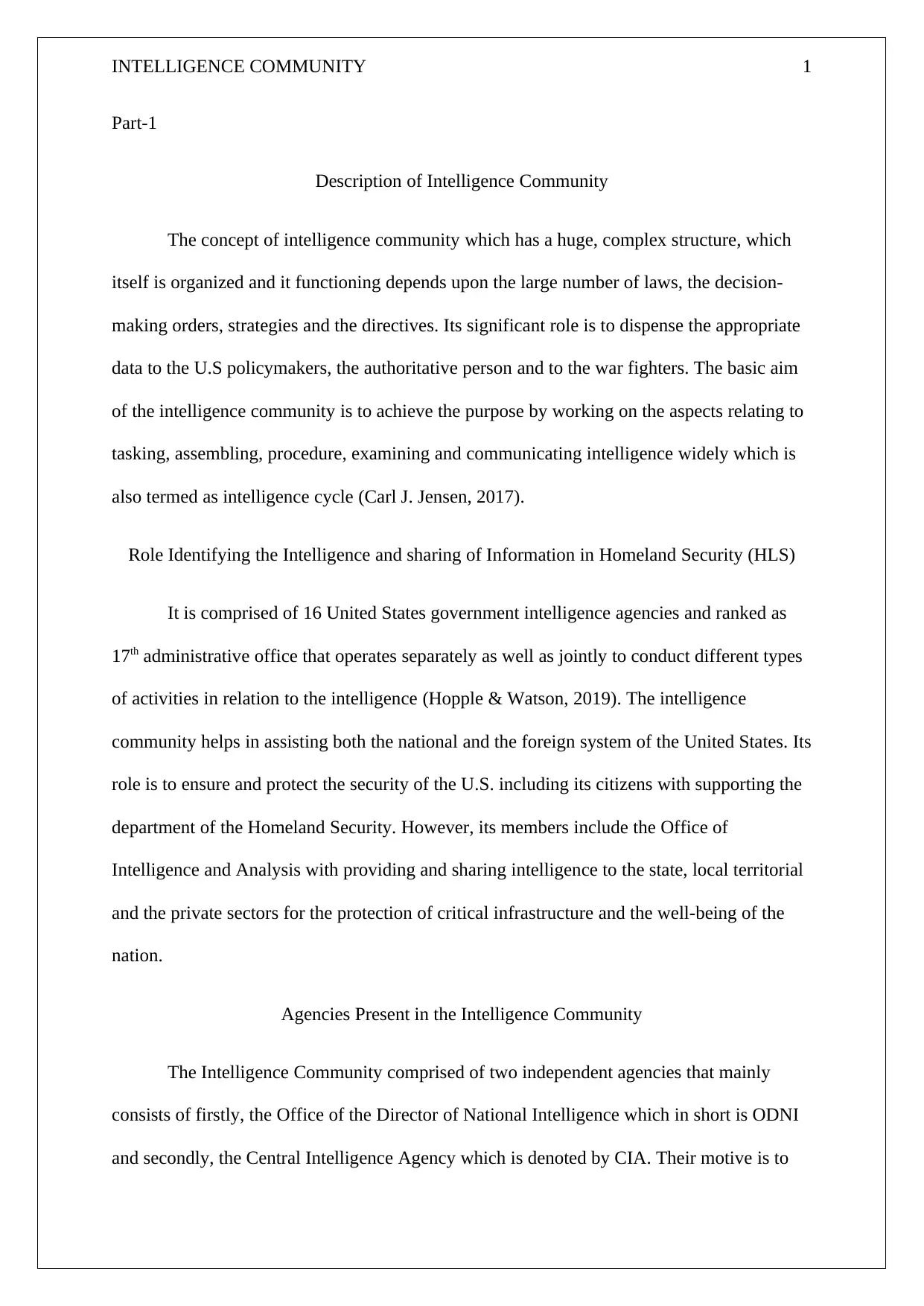
INTELLIGENCE COMMUNITY 1
Part-1
Description of Intelligence Community
The concept of intelligence community which has a huge, complex structure, which
itself is organized and it functioning depends upon the large number of laws, the decision-
making orders, strategies and the directives. Its significant role is to dispense the appropriate
data to the U.S policymakers, the authoritative person and to the war fighters. The basic aim
of the intelligence community is to achieve the purpose by working on the aspects relating to
tasking, assembling, procedure, examining and communicating intelligence widely which is
also termed as intelligence cycle (Carl J. Jensen, 2017).
Role Identifying the Intelligence and sharing of Information in Homeland Security (HLS)
It is comprised of 16 United States government intelligence agencies and ranked as
17th administrative office that operates separately as well as jointly to conduct different types
of activities in relation to the intelligence (Hopple & Watson, 2019). The intelligence
community helps in assisting both the national and the foreign system of the United States. Its
role is to ensure and protect the security of the U.S. including its citizens with supporting the
department of the Homeland Security. However, its members include the Office of
Intelligence and Analysis with providing and sharing intelligence to the state, local territorial
and the private sectors for the protection of critical infrastructure and the well-being of the
nation.
Agencies Present in the Intelligence Community
The Intelligence Community comprised of two independent agencies that mainly
consists of firstly, the Office of the Director of National Intelligence which in short is ODNI
and secondly, the Central Intelligence Agency which is denoted by CIA. Their motive is to
Part-1
Description of Intelligence Community
The concept of intelligence community which has a huge, complex structure, which
itself is organized and it functioning depends upon the large number of laws, the decision-
making orders, strategies and the directives. Its significant role is to dispense the appropriate
data to the U.S policymakers, the authoritative person and to the war fighters. The basic aim
of the intelligence community is to achieve the purpose by working on the aspects relating to
tasking, assembling, procedure, examining and communicating intelligence widely which is
also termed as intelligence cycle (Carl J. Jensen, 2017).
Role Identifying the Intelligence and sharing of Information in Homeland Security (HLS)
It is comprised of 16 United States government intelligence agencies and ranked as
17th administrative office that operates separately as well as jointly to conduct different types
of activities in relation to the intelligence (Hopple & Watson, 2019). The intelligence
community helps in assisting both the national and the foreign system of the United States. Its
role is to ensure and protect the security of the U.S. including its citizens with supporting the
department of the Homeland Security. However, its members include the Office of
Intelligence and Analysis with providing and sharing intelligence to the state, local territorial
and the private sectors for the protection of critical infrastructure and the well-being of the
nation.
Agencies Present in the Intelligence Community
The Intelligence Community comprised of two independent agencies that mainly
consists of firstly, the Office of the Director of National Intelligence which in short is ODNI
and secondly, the Central Intelligence Agency which is denoted by CIA. Their motive is to
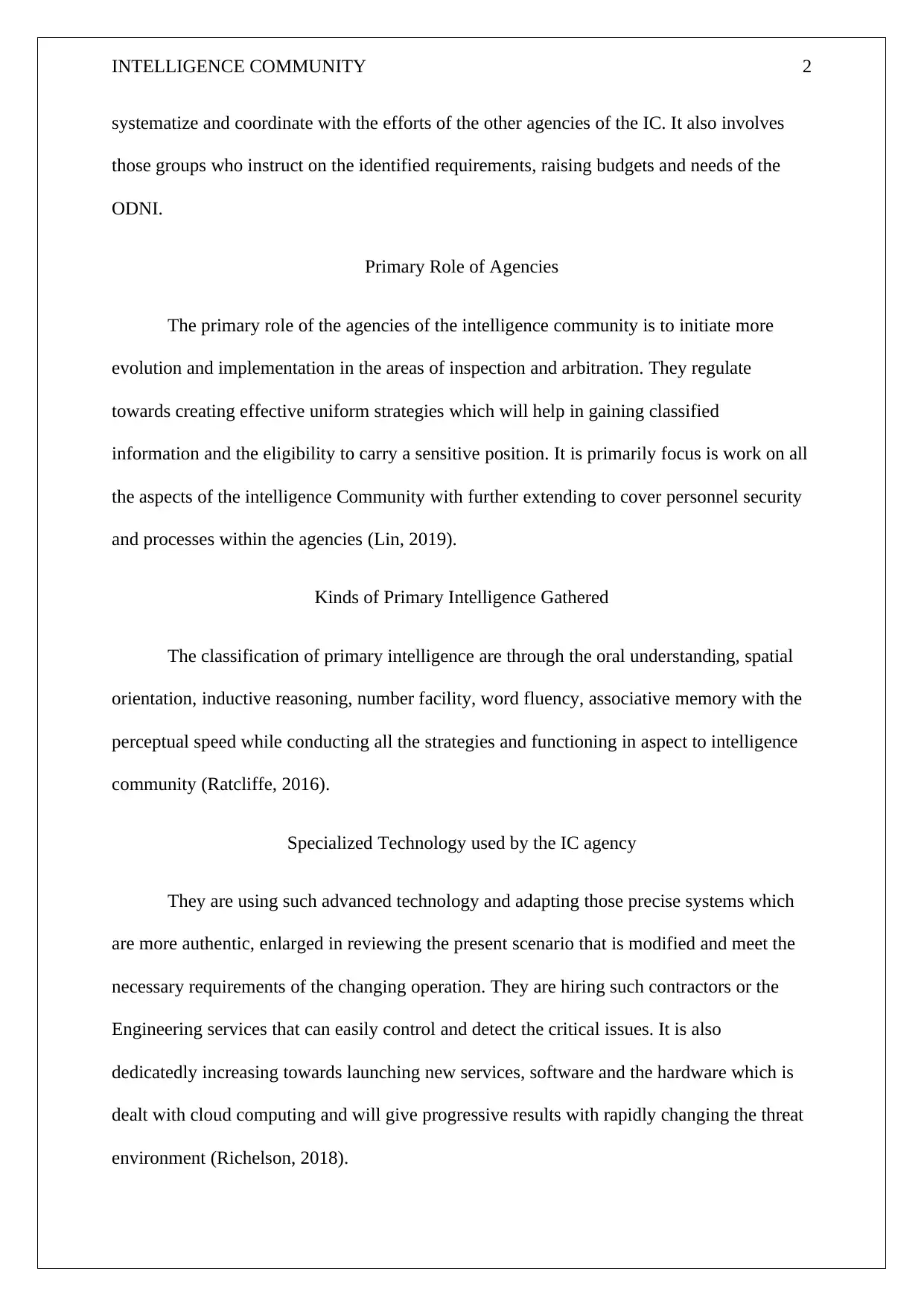
INTELLIGENCE COMMUNITY 2
systematize and coordinate with the efforts of the other agencies of the IC. It also involves
those groups who instruct on the identified requirements, raising budgets and needs of the
ODNI.
Primary Role of Agencies
The primary role of the agencies of the intelligence community is to initiate more
evolution and implementation in the areas of inspection and arbitration. They regulate
towards creating effective uniform strategies which will help in gaining classified
information and the eligibility to carry a sensitive position. It is primarily focus is work on all
the aspects of the intelligence Community with further extending to cover personnel security
and processes within the agencies (Lin, 2019).
Kinds of Primary Intelligence Gathered
The classification of primary intelligence are through the oral understanding, spatial
orientation, inductive reasoning, number facility, word fluency, associative memory with the
perceptual speed while conducting all the strategies and functioning in aspect to intelligence
community (Ratcliffe, 2016).
Specialized Technology used by the IC agency
They are using such advanced technology and adapting those precise systems which
are more authentic, enlarged in reviewing the present scenario that is modified and meet the
necessary requirements of the changing operation. They are hiring such contractors or the
Engineering services that can easily control and detect the critical issues. It is also
dedicatedly increasing towards launching new services, software and the hardware which is
dealt with cloud computing and will give progressive results with rapidly changing the threat
environment (Richelson, 2018).
systematize and coordinate with the efforts of the other agencies of the IC. It also involves
those groups who instruct on the identified requirements, raising budgets and needs of the
ODNI.
Primary Role of Agencies
The primary role of the agencies of the intelligence community is to initiate more
evolution and implementation in the areas of inspection and arbitration. They regulate
towards creating effective uniform strategies which will help in gaining classified
information and the eligibility to carry a sensitive position. It is primarily focus is work on all
the aspects of the intelligence Community with further extending to cover personnel security
and processes within the agencies (Lin, 2019).
Kinds of Primary Intelligence Gathered
The classification of primary intelligence are through the oral understanding, spatial
orientation, inductive reasoning, number facility, word fluency, associative memory with the
perceptual speed while conducting all the strategies and functioning in aspect to intelligence
community (Ratcliffe, 2016).
Specialized Technology used by the IC agency
They are using such advanced technology and adapting those precise systems which
are more authentic, enlarged in reviewing the present scenario that is modified and meet the
necessary requirements of the changing operation. They are hiring such contractors or the
Engineering services that can easily control and detect the critical issues. It is also
dedicatedly increasing towards launching new services, software and the hardware which is
dealt with cloud computing and will give progressive results with rapidly changing the threat
environment (Richelson, 2018).
⊘ This is a preview!⊘
Do you want full access?
Subscribe today to unlock all pages.

Trusted by 1+ million students worldwide
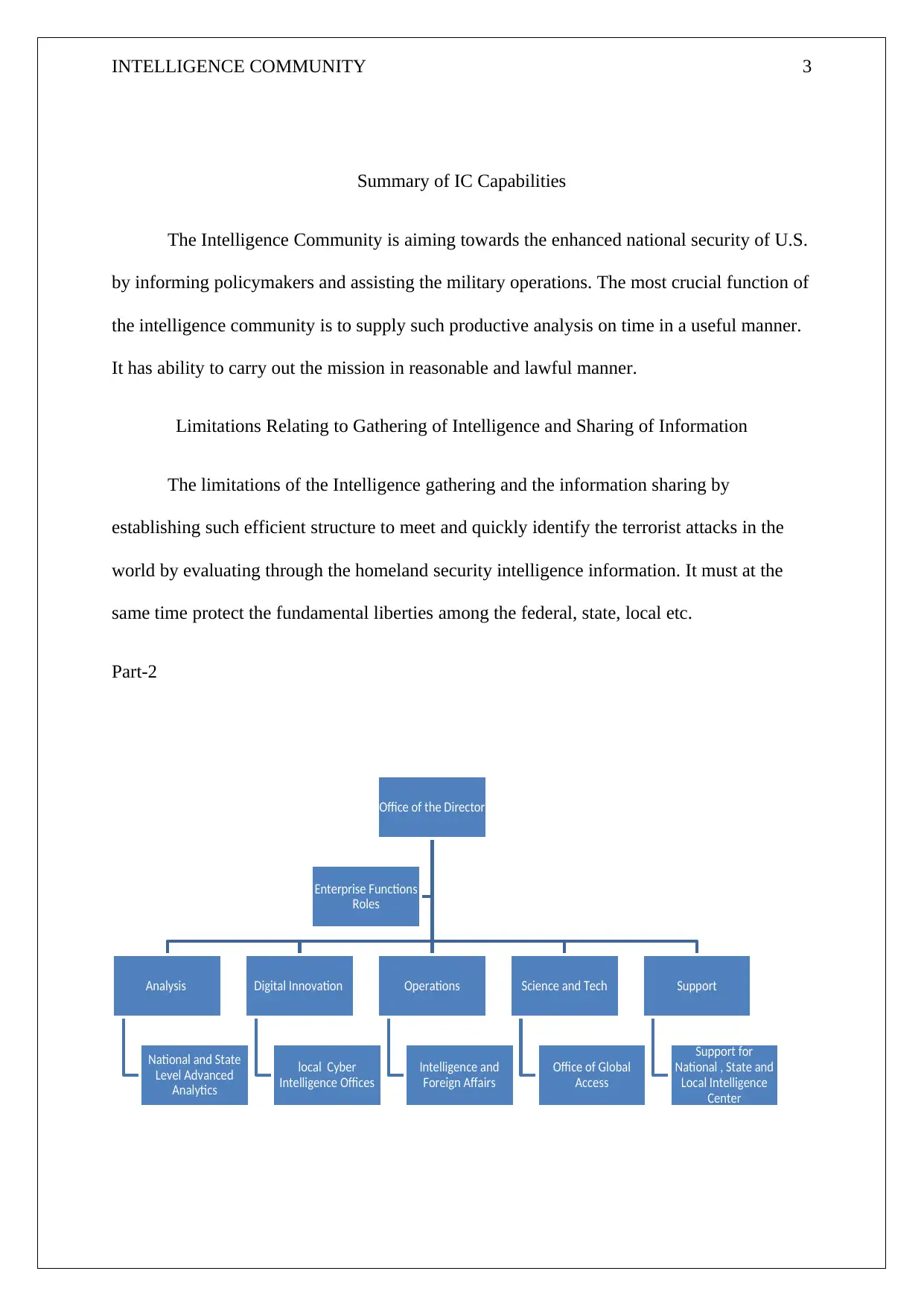
INTELLIGENCE COMMUNITY 3
Summary of IC Capabilities
The Intelligence Community is aiming towards the enhanced national security of U.S.
by informing policymakers and assisting the military operations. The most crucial function of
the intelligence community is to supply such productive analysis on time in a useful manner.
It has ability to carry out the mission in reasonable and lawful manner.
Limitations Relating to Gathering of Intelligence and Sharing of Information
The limitations of the Intelligence gathering and the information sharing by
establishing such efficient structure to meet and quickly identify the terrorist attacks in the
world by evaluating through the homeland security intelligence information. It must at the
same time protect the fundamental liberties among the federal, state, local etc.
Part-2
Office of the Director
Analysis
National and State
Level Advanced
Analytics
Digital Innovation
local Cyber
Intelligence Offices
Operations
Intelligence and
Foreign Affairs
Science and Tech
Office of Global
Access
Support
Support for
National , State and
Local Intelligence
Center
Enterprise Functions
Roles
Summary of IC Capabilities
The Intelligence Community is aiming towards the enhanced national security of U.S.
by informing policymakers and assisting the military operations. The most crucial function of
the intelligence community is to supply such productive analysis on time in a useful manner.
It has ability to carry out the mission in reasonable and lawful manner.
Limitations Relating to Gathering of Intelligence and Sharing of Information
The limitations of the Intelligence gathering and the information sharing by
establishing such efficient structure to meet and quickly identify the terrorist attacks in the
world by evaluating through the homeland security intelligence information. It must at the
same time protect the fundamental liberties among the federal, state, local etc.
Part-2
Office of the Director
Analysis
National and State
Level Advanced
Analytics
Digital Innovation
local Cyber
Intelligence Offices
Operations
Intelligence and
Foreign Affairs
Science and Tech
Office of Global
Access
Support
Support for
National , State and
Local Intelligence
Center
Enterprise Functions
Roles
Paraphrase This Document
Need a fresh take? Get an instant paraphrase of this document with our AI Paraphraser
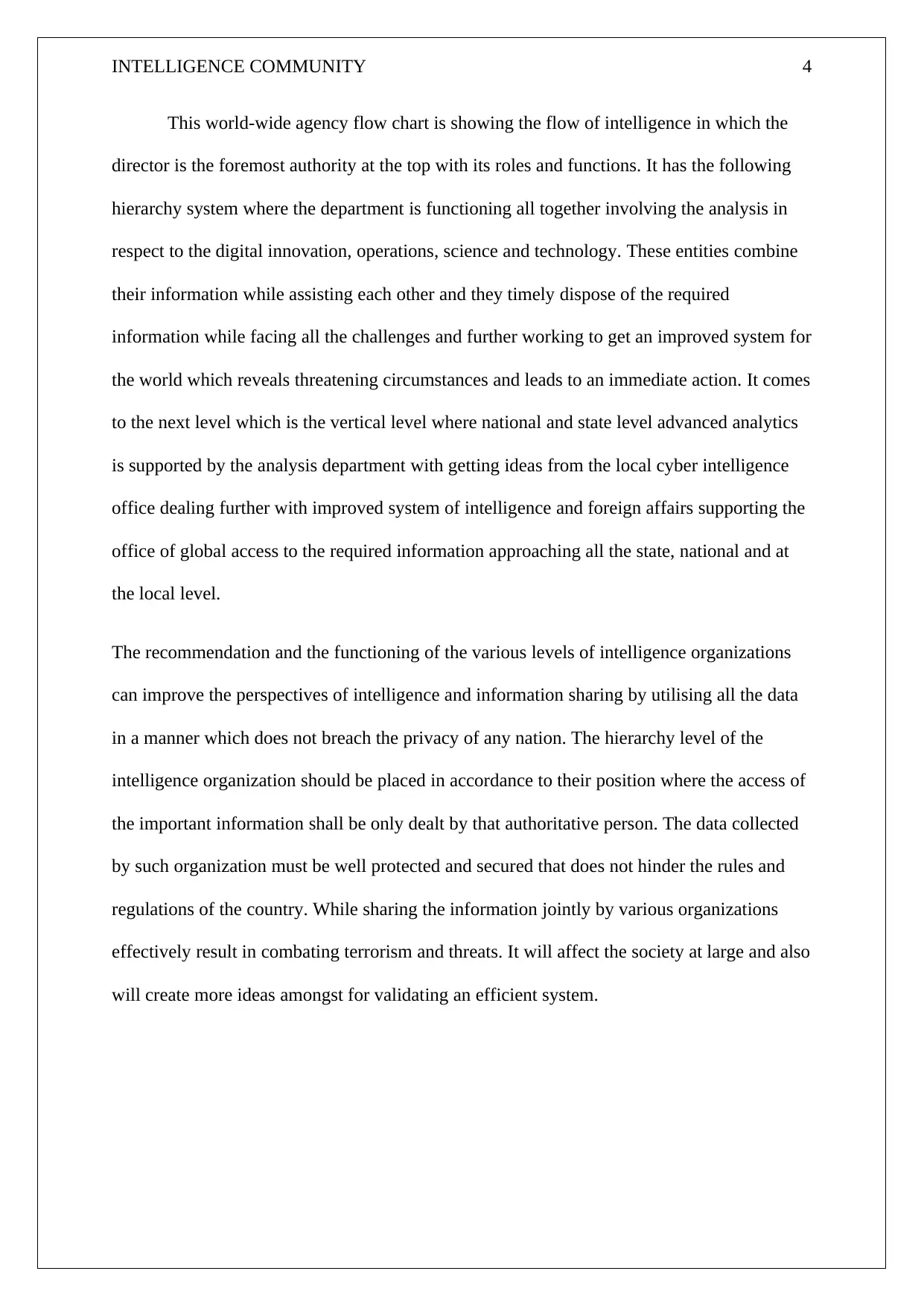
INTELLIGENCE COMMUNITY 4
This world-wide agency flow chart is showing the flow of intelligence in which the
director is the foremost authority at the top with its roles and functions. It has the following
hierarchy system where the department is functioning all together involving the analysis in
respect to the digital innovation, operations, science and technology. These entities combine
their information while assisting each other and they timely dispose of the required
information while facing all the challenges and further working to get an improved system for
the world which reveals threatening circumstances and leads to an immediate action. It comes
to the next level which is the vertical level where national and state level advanced analytics
is supported by the analysis department with getting ideas from the local cyber intelligence
office dealing further with improved system of intelligence and foreign affairs supporting the
office of global access to the required information approaching all the state, national and at
the local level.
The recommendation and the functioning of the various levels of intelligence organizations
can improve the perspectives of intelligence and information sharing by utilising all the data
in a manner which does not breach the privacy of any nation. The hierarchy level of the
intelligence organization should be placed in accordance to their position where the access of
the important information shall be only dealt by that authoritative person. The data collected
by such organization must be well protected and secured that does not hinder the rules and
regulations of the country. While sharing the information jointly by various organizations
effectively result in combating terrorism and threats. It will affect the society at large and also
will create more ideas amongst for validating an efficient system.
This world-wide agency flow chart is showing the flow of intelligence in which the
director is the foremost authority at the top with its roles and functions. It has the following
hierarchy system where the department is functioning all together involving the analysis in
respect to the digital innovation, operations, science and technology. These entities combine
their information while assisting each other and they timely dispose of the required
information while facing all the challenges and further working to get an improved system for
the world which reveals threatening circumstances and leads to an immediate action. It comes
to the next level which is the vertical level where national and state level advanced analytics
is supported by the analysis department with getting ideas from the local cyber intelligence
office dealing further with improved system of intelligence and foreign affairs supporting the
office of global access to the required information approaching all the state, national and at
the local level.
The recommendation and the functioning of the various levels of intelligence organizations
can improve the perspectives of intelligence and information sharing by utilising all the data
in a manner which does not breach the privacy of any nation. The hierarchy level of the
intelligence organization should be placed in accordance to their position where the access of
the important information shall be only dealt by that authoritative person. The data collected
by such organization must be well protected and secured that does not hinder the rules and
regulations of the country. While sharing the information jointly by various organizations
effectively result in combating terrorism and threats. It will affect the society at large and also
will create more ideas amongst for validating an efficient system.
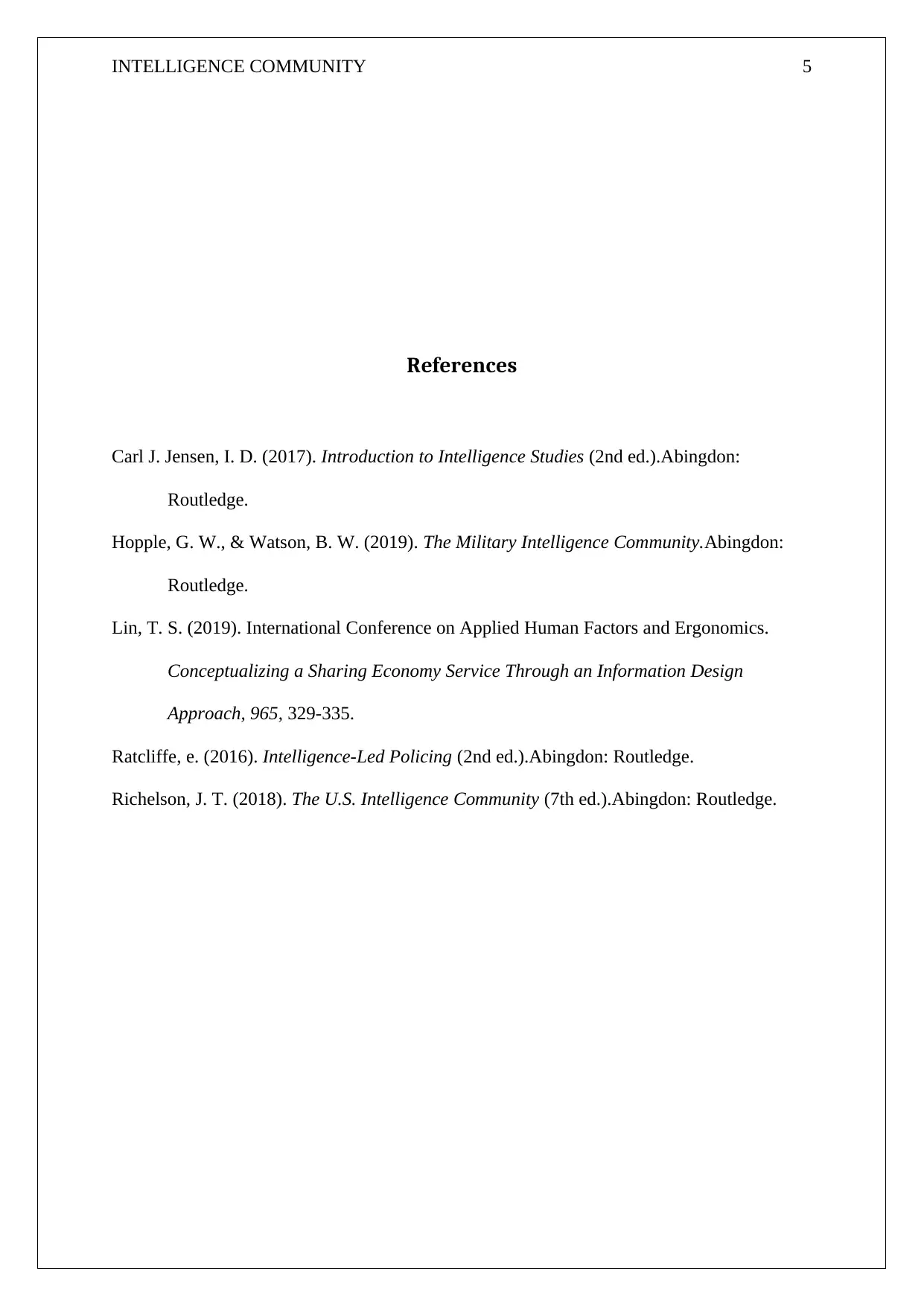
INTELLIGENCE COMMUNITY 5
References
Carl J. Jensen, I. D. (2017). Introduction to Intelligence Studies (2nd ed.).Abingdon:
Routledge.
Hopple, G. W., & Watson, B. W. (2019). The Military Intelligence Community.Abingdon:
Routledge.
Lin, T. S. (2019). International Conference on Applied Human Factors and Ergonomics.
Conceptualizing a Sharing Economy Service Through an Information Design
Approach, 965, 329-335.
Ratcliffe, e. (2016). Intelligence-Led Policing (2nd ed.).Abingdon: Routledge.
Richelson, J. T. (2018). The U.S. Intelligence Community (7th ed.).Abingdon: Routledge.
References
Carl J. Jensen, I. D. (2017). Introduction to Intelligence Studies (2nd ed.).Abingdon:
Routledge.
Hopple, G. W., & Watson, B. W. (2019). The Military Intelligence Community.Abingdon:
Routledge.
Lin, T. S. (2019). International Conference on Applied Human Factors and Ergonomics.
Conceptualizing a Sharing Economy Service Through an Information Design
Approach, 965, 329-335.
Ratcliffe, e. (2016). Intelligence-Led Policing (2nd ed.).Abingdon: Routledge.
Richelson, J. T. (2018). The U.S. Intelligence Community (7th ed.).Abingdon: Routledge.
⊘ This is a preview!⊘
Do you want full access?
Subscribe today to unlock all pages.

Trusted by 1+ million students worldwide
1 out of 6
Related Documents
Your All-in-One AI-Powered Toolkit for Academic Success.
+13062052269
info@desklib.com
Available 24*7 on WhatsApp / Email
![[object Object]](/_next/static/media/star-bottom.7253800d.svg)
Unlock your academic potential
Copyright © 2020–2025 A2Z Services. All Rights Reserved. Developed and managed by ZUCOL.





